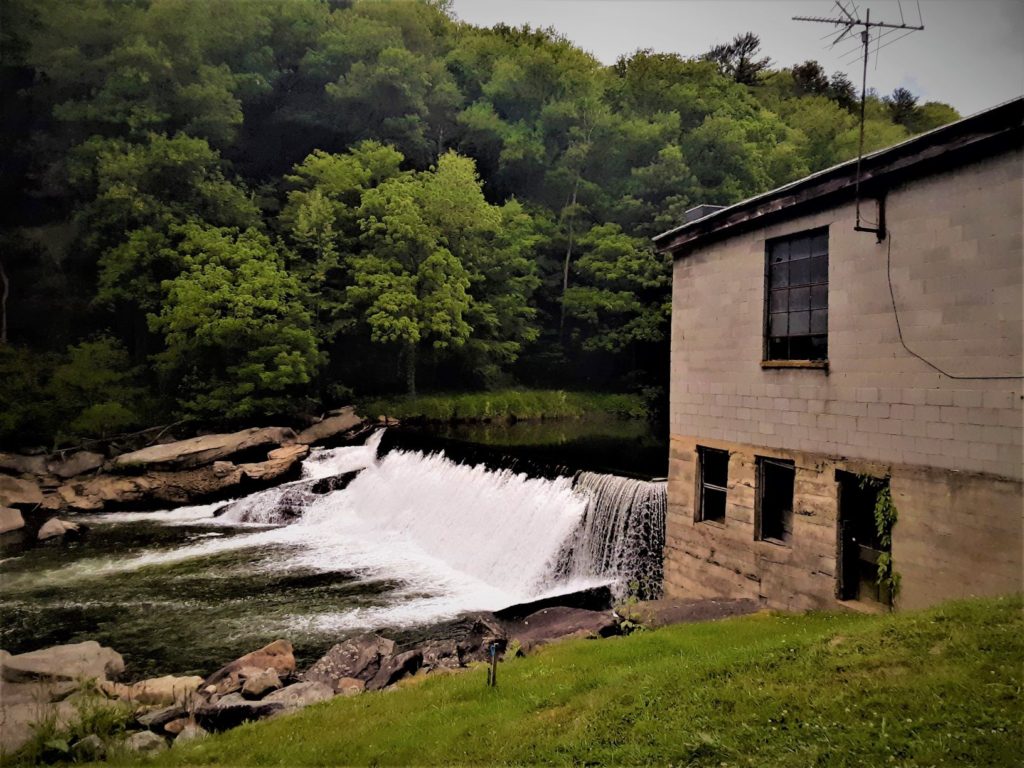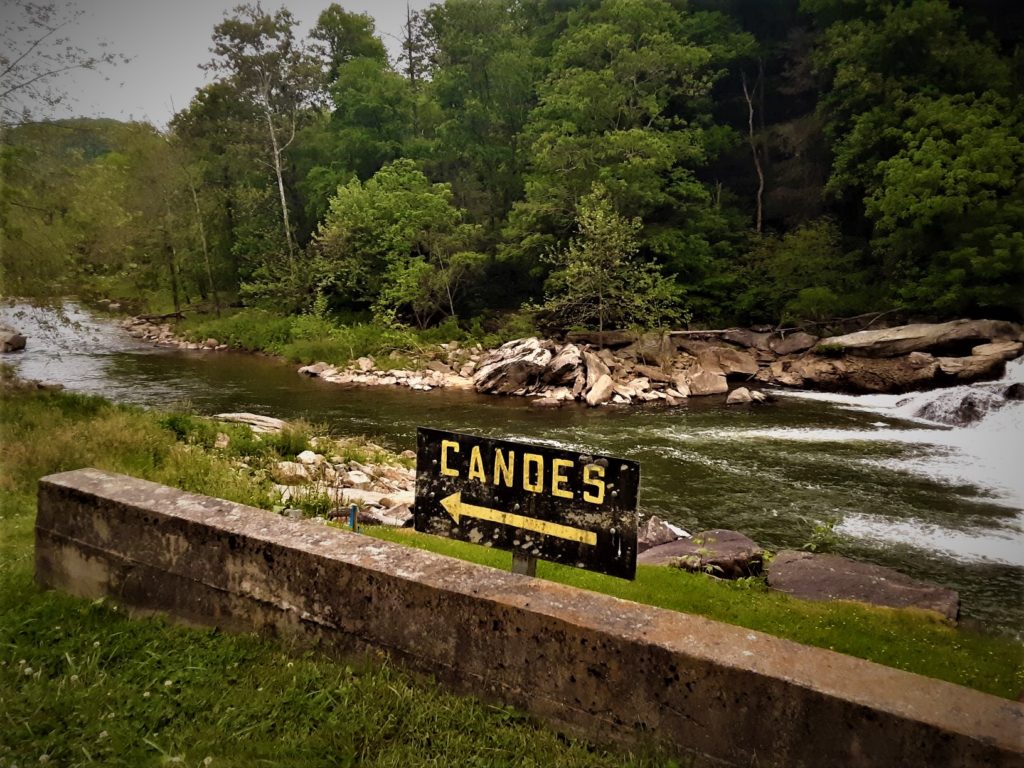Editor’s Note: In 1975, Foxfire published a 75-page history of Ben Ward and his dam and saw mill operation along the Watauga River. Much of the history below is derived from the Foxfire account.
The Ward’s Mill Dam is planned to be torn down in 2020.

Ben Ward & the Ward Mill Dam
The story of the late Ben Ward and his mill on the Watauga River in Sugar Grove is fascinating.
Known to be a “tinkerer” and a baseball fanatic, Ben was a brilliant, self-taught engineer. He came from a line of innovative Wards and tenacious Harmons that settled in the High Country in the late ‘1700s
One grandfather built a washing machine powered by a waterwheel in a creek. And his father built the original dam and water-powered mill on the Watauga River in Sugar Grove. This was the only local dam to survive the historic 1940 flood.
Born in 1896, Ben was raised only 150 feet from the dam. After serving in the Navy during World War I, Ben returned to Western North Carolina, where he built a sawmill from parts of a few other mills and sawed timber throughout Watauga County and Graham County, near the Great Smoky Mountains.
Tragedy Hits Home

In the summer of 1930, tragedy struck.
His wife, Lillie, died of rheumatic fever two months after giving birth to their son, Ray. The death of Lillie sent Ben into a tailspin. Though he would fight mental anguish until he committed suicide in 1970, Ben was in and out of VA hospitals for the next few years. In that time, he received more than 50 shock treatments.
Upon his release from the VA hospital in Perry Point, Md., Ben retrieved his sawmill in the Smokies and set it up along the Watauga River, in the same spot his father operated the first mill in the community.
Powered by the river, Ben operated a gristmill for corn, a hammer mill for cow feed and a saw mill. The former two weren’t worth the effort after a while. But Ben did saw an estimated 25-million-board feet with his sawmill over the years. He also planted more than 100,000 pine and poplar trees.
Ben also added a generator at some point and created electricity for nearby houses. Because no power companies existed in the area at the time, the local utilities board allowed Ben to power homes within a 5-mile radius of his mill. So he produced electricity for 15 homes for $1 per month and a church for free.
“But the power company came through here and took over all these little franchises, and they said then that he could only generate power to within a 200-foot radius of the mill, and so he generated just for himself after that,” his son, Ray, told Foxfire in the ‘70s for its 6th edition.
Rebuilding After the 1940 Flood
The 1940 flood washed away the mills and 100,000 feet of lumber. The hemlock dam his father built survived. But Ben rebuilt the saw mill the following year and continued improving his milling system over the years. In 1953, he turned his 4-foot band mill into a 6-foot band mill, truing the drums himself because no local machinists knew how.
He learned how to make his own sawmill blades with a hydraulic punch and how to sharpen them with his own devised system. He improved a log-turning device that he previously patented and was working on how to make sawmills more portable. But replacing the log dam his father built with a concrete dam was his last major improvement on the mill.
Ray said he saw his father looking out over the river one summer day and proceeded to shut down the mill. He was going to build the concrete dam that Ben’s father always envisioned.
“Something just told me,” Ben said later, “that if I was ever going to build that dam this was the time.”

With the help of Roy Hodges, Henry Hicks and brothers Paul and Larry Rominger, Ben started the project around Labor Day in 1963 when the water on the river was low. The dam wasn’t overflowing because most of the water on the river was running through the water wheels.
Roy worked in water up to his chin for a couple day nailing piling boards to four popular logs. Henry ran the concrete mixer until he was hurt in the eye when blasting rock. Ray estimated that Paul and Larry wheelbarrowed and hauled 5,000 bags of cement, mixing about 75 bags per day in a one-bag mixer. They poured concrete until Thanksgiving Day.
In all, an estimated 18 people helped build the dam, Hicks told the Foxfire publication.
“If you was going to contract [to have a dam like that done today] it would cost a half a million dollars trying to figure out how to do it. That’s right, too,” Hicks said.
And he said that in 1975! Who knows how much the design and construction of the dam would cost today.
The dam, which includes a built-in ladder on the far side of the river for trout and bass to climb up, was completed in June 1964. Until his death several years later, he continued producing power for himself and milling lumber.
His son, Ray, took over operating the mill and maintaining the dam, and he did so for decades after his father’s death. It wasn’t until just a couple years ago that the dam stopped generating power.
The 2020 Planned Removal of Ward Dam
The Federal Energy Regulatory Commission regulates hydroelectric dams. In 2017, Ray Ward was approved for another 30-year license to operate his dam. However, he surrendered the license for a variety of reasons.
In 2020, the dam is planned to be removed.
For more details, click the article I wrote announcing the planned demolition of the Ward Dam along the Watauga River. It includes comments from Virginia Ward, wife of Ray, talking about the bittersweet nature of removing the dam and letting the river flow.
Technical Details of Ward Mill Dam
The following comes from a Federal Energy Regulatory Commission document regarding the dam and mill along the Watauga River in Sugar Grove.
- The Ward Mill Project consists of a 130-foot-long, 20-foot-high rock and concrete dam that contains two gates.
- The dam impounds a 2,500-foot-long, 4.6-acre impoundment with a gross storage capacity of 16.3 acre-feet.
- Flow from the impoundment passes into the project’s intake structure, which includes trash racks, with 1-inch spacing, and a 14-foot-long, 5-foot-wide, 7.5-foot-tall penstock made of rock, reinforced concrete, and steel.
- Flow from the penstock into the 14-foot-long, 8-footwide, and 23-foot-deep powerhouse is controlled by a 6.5-foot-wide, 8-foot-tall vertical headgate.
- The powerhouse contains two 30-inch-diameter turbines, with capacities of 75 kW and 93 kW, for a total installed capacity of 168 kW.
- Flow through the turbines is controlled by wicket gates that are activated by a pneumatic gate control.
- From the turbines, water flows into a draft tube that returns water to the river at the toe of the dam through a 6-foot-wide, 5-foot-tall opening in the wall beneath the powerhouse.
I think while this is a privately owned operation and site, that the local and even broader communities feel that this project was sprung upon them without chance for debate or investigation into options. Its historical significance should not be dismissed or treated with an assumed second place to that of nature.
While arguments for improved local ecology also have merit, I think that their focus and the project’s sudden announcement has caught the local community off guard. Consequently, they may succeed before all voices and opinions have been heard.
I would like to know, Agreement that most man mad structures normally change natures course to the detriment, see Sarasota florida midnight pass, However the length that this damn has been in place nature has adjusted for it and environments recreated. Removal of this damn will create a whole new flow and possible ecosystem destroying what has been I. Place for a long time. What is the effect of the removal?
This dam should be listed as a national historic site to what ingenuity can do in spite of mental illness. Ben was a marvel. As Booker T. Washington said, “The true measure of a man is not what he has achieved, but what what he has overcome.” Locals need to fight the dam’s destruction.